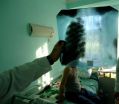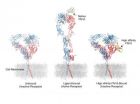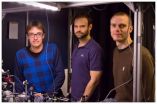(Press-News.org) Parents are strong influences in the lives of young children, with patterns of behaviour established in the early years laying the foundation for future choices. A new study suggests that, when it comes to levels of physical activity, it is mothers who set (or don't set) the pace.
An analysis of the physical activity levels of more than 500 mothers and pre-schoolers, assessed using activity monitors to produce accurate data, found that the amount of activity that a mother and her child did each day was closely related. Overall, maternal activity levels were strikingly low: only 53% of mothers engaged in 30 minutes of moderate-to-vigorous physical activity at least once a week. The UK Government recommends achieving 150 minutes of at least 'moderate intensity physical activity' (such as brisk walking) over the week as one of the ways of achieving its physical activity guidelines.
The results of the study are published in the journal Pediatrics on 24 March 2014. The paper 'Activity Levels in Mothers and Their Preschool Children' suggests that, given the link between mothers and young children, policies to improve children's health should be directed to whole families and seek to engage mothers in particular.
The research was overseen by Dr Esther van Sluijs at the MRC Epidemiology Unit and the Centre for Diet and Activity Research, University of Cambridge, and led by Kathryn Hesketh (formerly of Cambridge and now UCL), in collaboration with researchers at the MRC Lifecourse Epidemiology Unit, University of Southampton.
The study is the first to show a direct association in a large sample of mothers and children, both fitted with activity monitors at the same time. It shows that young children are not 'just naturally active' and that parents have an important role to play in the development of healthy activity habits early on in life. The research also provides important evidence for policy makers to inform programmes that promote physical activity in families with young children. Its findings suggest that all family members can benefit from such efforts.
It is well established that physical activity is closely linked to health and disease prevention. Research shows that active mothers appear to have active school-aged children, who are in turn more likely than their less active peers to have good health outcomes. However, there has been little large-scale research into the association between the activity of mothers and that of preschool-aged children or about the demographic and temporal factors that influence activity levels in mothers of young children.
The research published in the Pediatrics paper drew on data obtained from 554 women and their four-year-old children who are participants in the Southampton Women's Survey, devised and run by the MRC Lifecourse Epidemiology Unit. A major longitudinal study initiated in the late 1990s, the project is following women who were first interviewed in their 20s and 30s, many of whom subsequently gave birth. From confirmation of pregnancy, the programme assesses the health and development of the children born to women in the survey.
Of the 554 mothers whose data was analysed in the Cambridge-led study, many were working and many of the children attended day-care facilities – factors that influenced activity levels of both mothers and children, as well as the association between the two. Other potential influences on maternal activity examined in the study included maternal education, whether the child had siblings, and whether his or her father was present at home.
While previous studies have used a self-report approach to measure activity, in the Southampton Women's Survey both mothers and youngsters were fitted with Actiheart monitors (combined accelerometer and heart rate monitor) to record with a high degree of accuracy their physical activity levels for up to a week with a high degree of accuracy. "We used an activity monitor that was attached to participants and worn continuously, even during sleep and water-based activity," said van Sluijs.
"This approach allowed us to capture accurately both mothers' and children's physical activity levels for the whole of the measurement period, matching hour for hour maternal-child activity levels. This comparison provided us with detailed information about how the association between mothers and children's activity changed throughout the day, and how factors such as childcare attendance and maternal education influenced this relationship."
The activity levels of parent and child were, for the first time, recorded over whole daytime periods for up to seven days. The resulting data allowed the researchers to plot physical activity throughout the day and over the course of an entire week to see how activities varied across the day and how weekday activity levels compared with weekend activity levels.
The data from mother and child were matched up to see if and how the activity patterns of adults and children correlated. "We saw a direct, positive association between physical activity in children and their mothers – the more activity a mother did, the more active her child. Although it is not possible to tell from this study whether active children were making their mothers run around after them, it is likely that activity in one of the pair influences activity in the other," said Hesketh.
"For every minute of moderate-to-vigorous activity a mother engaged in, her child was more likely to engage in 10% more of the same level of activity. If a mother was one hour less sedentary per day, her child may have spent 10 minutes less sedentary per day. Such small minute-by-minute differences may therefore represent a non-trivial amount of activity over the course of a week, month and year."
The direct positive association between mothers and their four-year-old children was apparent for overall daily activity levels and activity segmented over the day (morning, afternoon and evening). This finding suggests that mothers and their children are active concurrently. However, the association differed by child's weight status, time spent at preschool, duration of mother's schooling and by time of day and week.
"Our study shows that the relationship between mother and child activity is moderated by demographic and time factors – for example, for moderate-to-vigorous activity, the relationship was stronger for mothers who left school aged 16 compared to those who left aged 18 or more. The association also differed by time of week, with light activity, such as walking, most strongly associated at weekends than on weekdays. The opposite was observed for moderate-to-vigorous activity which was more strongly associated on weekdays," said van Sluijs.
The research adds a further dimension to what is already known about levels of physical activity in children and adults. Despite strong evidence of the benefits of exercise, activity levels decrease through childhood and into adulthood. This decline extends into the childbearing years. New parents tend to be less active than peers without children and more likely to fail to meet recommended guidelines.
Once women become mothers their activity levels frequently fail to return to pre-parenthood levels and their relative lack of activity may influence that of their small children. "There are many competing priorities for new parents and making time to be active may not always be top of the list. However, small increases in maternal activity levels may lead to benefits for mothers and children. And if activity in mothers and children can be encouraged or incorporated into daily activities, so that more time is spent moving, activity levels are likely to increase in both. In return, this is likely to have long-term health benefits for both," said Hesketh.
INFORMATION: END
When mothers are active so are their children -- but many mothers are not
2014-03-24
ELSE PRESS RELEASES FROM THIS DATE:
Integrating mental health services in pediatric practices feasible, effective, Pitt finds
2014-03-24
PITTSBURGH, March 24, 2014 – Brief behavioral and mental health programs for children can be effectively provided within pediatric practices as an alternative to being referred to a community specialist, University of Pittsburgh Schools of the Health Sciences researchers found in a National Institutes of Health-funded randomized trial.
Behavioral health treatment provided in the pediatrician's office resulted in improved access to care, greater participation by both the child and their caregiver in treatment programs, and higher rates of treatment completion, without ...
Use of mood-stabilizing drug linked with reduced risk of developing head and neck cancer
2014-03-24
A new study indicates that a commonly used mood stabilizing drug may help prevent head and neck cancer. The study is published early online in Cancer, a peer-reviewed journal of the American Cancer Society.
Valproic acid (VPA) is currently prescribed as an anti-seizure medication and mood stabilizer, but it is also being studied as an anticancer agent because it inhibits histone acetyl transferases, which help control gene expression by changing DNA structure.
Johann Christoph Brandes MD, PhD, of the Atlanta Veterans Affairs Medical Center and Emory University in Atlanta, ...
New consensus reached to help tackle multidrug-resistant and extensively drug-resistant TB
2014-03-24
New consensus statements have been developed to help tackle the growing threat of multidrug-resistant tuberculosis (TB) and extensively drug-resistant tuberculosis (TB).
Published online today (24 March 2014) in the European Respiratory Journal¸ the statements mark the first time that physicians who treat patients with multidrug- and extensively drug-resistant TB have reached a consensus on important areas of patient management where scientific evidence is inconclusive.
The World Health Organization (WHO) estimates that currently 450,000 new cases with MDR-TB occur ...
The Lancet journals: World TB Day media alert
2014-03-24
To mark the Stop TB Partnerships' World TB Day on Monday 24 March 2014, The Lancet journals will publish a special new collection of Reviews, Comment, and Articles to cast light, and the world's attention, on tuberculosis, in the hope of raising this disease higher up the agendas of international communities.
The new publications discuss topics ranging from extremely drug-resistant tuberculosis, to the role of advocacy in tuberculosis, and new anti-tuberculosis drugs, highlighting the key areas and challenges to be met if inroads are to be made into winning the battle ...
New childhood tuberculosis estimates double the number previously thought
2014-03-24
Researchers from Brigham and Women's Hospital (BWH) and Harvard Medical School (HMS) in Boston have estimated that around one million children suffer from tuberculosis (TB) annually— twice the number previously thought to have tuberculosis and three times the number that are diagnosed every year. The researchers also estimated that around 32,000 children suffer from multidrug-resistant tuberculosis (MDR-TB) annually. These findings are published in The Lancet on March 23, 2014.
"Despite children comprising approximately one quarter of the world's population, there ...
Mass. General study identifies path to safer drugs for heart disease, cancer
2014-03-23
Massachusetts General Hospital (MGH) investigators may have found a way to solve a problem that has plagued a group of drugs called ligand-mimicking integrin inhibitors, which have the potential to treat conditions ranging from heart attacks to cancer metastasis. In a Nature Structural & Molecular Biology paper receiving advance online publication, the researchers provide a structural basis for the design of new and safer integrin inhibitors.
Integrins are receptor proteins found on the surface of cells that determine whether or not cells adhere to adjacent cells and ...
Unavoidable disorder used to build nanolaser
2014-03-23
Researchers the world round are working to develop optical chips, where light can be controlled with nanostructures. These could be used for future circuits based on light (photons) instead of electron - that is photonics instead of electronics. But it has proved to be impossible to achieve perfect photonic nanostructures: they are inevitably a little bit imperfect. Now researchers at the Niels Bohr Institute in collaboration with DTU have discovered that imperfect nanostructures can offer entirely new functionalities. They have shown that imperfect optical chips can be ...
Could diamonds be a computer's best friend?
2014-03-23
COLUMBUS, Ohio—For the first time, physicists have demonstrated that information can flow through a diamond wire.
In the experiment, electrons did not flow through diamond as they do in traditional electronics; rather, they stayed in place and passed along a magnetic effect called "spin" to each other down the wire—like a row of sports spectators doing "the wave."
Spin could one day be used to transmit data in computer circuits—and this new experiment, done at The Ohio State University, revealed that diamond transmits spin better than most metals in which researchers ...
Leukaemia caused by chromosome catastrophe
2014-03-23
Researchers have found that people born with a rare abnormality of their chromosomes have a 2,700-fold increased risk of a rare childhood leukaemia. In this abnormality, two specific chromosomes are fused together but become prone to catastrophic shattering.
Acute lymphoblastic leukaemia, or ALL, is the most common childhood cancer. Scientists previously found that a small subset of ALL patients have repeated sections of chromosome 21 in the genomes of their leukaemia cells. This form of ALL – iAMP21 ALL – requires more intensive treatment than many other types of ALL. ...
Drugs fail to reawaken dormant HIV infection
2014-03-23
Scientists at Johns Hopkins report that compounds they hoped would "wake up" dormant reservoirs of HIV inside immune system T cells — a strategy designed to reverse latency and make the cells vulnerable to destruction — have failed to do so in laboratory tests of such white blood cells taken directly from patients infected with HIV.
"Despite our high hopes, none of the compounds we tested in HIV-infected cells taken directly from patients activated the latent virus," says Robert F. Siliciano, M.D., Ph.D., a professor of medicine at the Johns Hopkins University School ...



